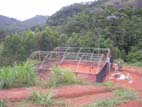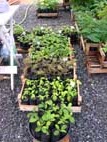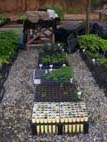The first year (2005)
[ Previous Brazil
| Main Brazil
| Home ]
Based on our experience in the initial orientation we
decided to slow down a little bit. The orientation phase had to be extended for
at least another two years. We had some small patches of land (ours and that of
several friends, all pieces in the order of 1 ha). Several small remote patches
are not a forest, but it is enough to gain experience. We started reading and
experimenting.
Seed
Very helpful for us has been the book about seeds: Guide to Handling Tropical and Subtropical Forest Seed, Lars Schmidt, DFSC 2000.
Fortunately the region produces seeds of various species every week of the year. Collecting seed proved to be the expected challenge.
But the tropical seeds have definitely less dormancy problems than the
temperate species, so we had germination percentages above our original
estimates. The seeds, that you want, are always out of reach. This resulted in
an investment in tree climbing equipment and climbing courses. At http://wesspur.com/ they were extremely helpful,
explained details, gave suggestions, simply perfect.
Greenhouse
Constructing an advanced greenhouse with climate control, as
we are used to here in the Netherlands, was impossible. Materials werenít
available locally, neither were the construction skills. Fortunately a local
Bromelia cultivator suggested a supplier from Sao Paulo and gave us suggestions
about the construction of a simple greenhouse. Zuzu Bromelias pointerÖ.
 [Greenhouse details]
[Greenhouse details]
Plastic bags
Several persons gave us an excellent advice: donít do serious financial investments in any major equipment in the beginning.
So donít buy a tractor etc.
But in the case of plastic bags we took that advice (not spending money) too far.
Nobody said we shouldnít use real containers for seedlings. That choice was self inflicted.
Donít make the same mistake, use real containers.
We had of course heard and read about the special air pruning containers for trees, but never the less we decided to work with the small plastic bags.
Now we know very precisely why most of the local seedlings are of limited quality.
The, unavoidable, instantaneous spiraling of the roots at the bottom of the plastic bag is disastrous.
Not only does it cause fungus problems, dying roots, nutritional problems and more, it also seems to produce
problems later on when the spiraled roots fail to give the tree proper support against wind forces.
We tried everything in the books to solve this.
But we stopped using plastic bags.
Now we only refer to this phase using anecdotes.
Where the literature mentions stress problems when planting seedlings in the field, we called it relief. We did plant the troublesome seedlings from the plastic bags period. We needed the planting experience and wanted to compare with container produced seedlings.
Buying the high-tech containers seems like a serious investment at first.
But the reduced labor cost for filling the rigid containers with substrate, already pays for the containers.
Really, do not make the same mistake (donít use plastic bags).
 [Plastic bags details]
[Plastic bags details]
Containers
A local Brazilian supplier for containers is http://www.mecprec.com.br.
They have various sizes. The 53 cm≥ containers are the traditional containers for Eucalyptus and proved too small for us. They are
cheap and require only small amounts of substrate.
Some species germinate perfectly in them, and donít have too many root problems in the beginning.
But irrigating them requires much better control then we can provide manually.
The volume of the container is small, so the absolute amount of water is small too.
An unexpected change in weather, higher intensity of the sunshine, a higher
temperature and/or more wind, is a serious risk of moisture stress.
Or even worse: dry substrate.
And that is irreversible damage.
Containers with a volume of 140 cm≥ or more were fine for us. Between their 280 cm≥ container and their 3500 cm≥ container is a huge gap. And some species
seem to have roots that really need some space (20 cm or more).
So we had to buy containers from foreign suppliers.
Importing anything into Brazil is a nightmare.
But even for our small greenhouse the number of containers is too large to simply bring them into the country in normal traveling luggage.
And you cannot import more than USD 500 at a time per person.
We tried for more then six months to get a small shipment of Treepotsô and Deepotsô into Brazil.
But lost the whole shipment because of import bureaucracy.
There are lots of places to buy pots.
But if you want a US address, where they have an enormous variety of containers and other goodies, then visit http://www.stuewe.com.
They were extremely helpful, explained details, gave suggestions, simply perfect.
Their packaging and shipping service is perfect too.
But understandably they donít ship directly to Brazil.
We currently experiment with some containers that we bought there.
We try Ray Leach ďCone-tainerĒô (ESC10 combined with Ultra Sleeve).
Importing them in to Brazil was too difficult.
So they came with traveling luggage.
Do take a look at http://www.rootrainers.com.
The containers from Spencer-Lemaire are too good to be true.
The folks at Spencer-Lemaire were extremely helpful, explained details, gave suggestions, simply perfect.
We grow an unlimited number of species.
It is hard to get information on rooting habits, nutrient usage etc.
The Rootrainers can be opened (as a book) to inspect moisture content and root development.
The simple access is very important for us.
We use the smaller sizes just for germination of some species with short-fine roots.
But once the seedling starts to grow the limited volume becomes a risk for our simple manual greenhouse.
The largest containers (Tinus: 350 cm≥) can actually be used for some time without almost immediately repricking into larger containers.
We prefer to put several seeds into one container and just cut away seedlings if more than one seed germinates in the same container.
But even transplanting to other containers is simple and quick because the Rootrainers open like a book.
We also have some samples from BCC AB and large quantities from
Cetap.
 [Container details]
[Container details]
Acid soil
The well documented problems with acidity and leaching of
the tropical soils were new to some of us. Part of preparation for
reforestation is soil analysis. Some steep sandy soil patches had a pH 4.5, Ca
0.4 cmol/dm≥, Al 1 cmol/dm≥. Because of the vegetation (some grasses and
ferns) the soil can immediately be recognized as problematic, but the soil
analysis left no doubt. Without supplements trees will not grow easily on this
soil, except for some pioneers. For the time being we resort to lime deep in
the planting hole, but sooner or later we have to investigate if there are
other, more biological, ways to solve acidity and Al toxicity problems.
Planting holes
Preparing soil for planting is expensive. Physical
preparation of a serious hole is almost impossible when using only manual labor
(without machines). Lots of people are for instance willing to plant lots of
trees on their land. We have ample supply of seedlings from our experiments. The
combination seems logical. But is didnít work out that way. Using manual labor,
a single person can only prepare 10 to 20 holes per day. That is too much for a
good willing amateur. And then one also has to mix in some lime, wait for some
days/weeks and mix some other nutrients into the hole. Improving the soil is
normally required in our region. Manual preparation of soil for tree planting is
simply too much work. Besides that it causes damage to the back of the planter.
Even in wet, clay rich soil, we can now prepare 10-20 holes
per hour, without huge investments. We used a small (Stihl BT121) Earth
Auger to open/loosen the soil. But it requires some hardware
modifications/improvements on the knife at the tip of the auger.
[ Next Brazil ]